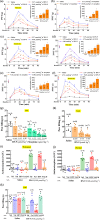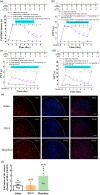The multifunctional peptide DN-9 produced peripherally acting antinociception in inflammatory and neuropathic pain via μ- and κ-opioid receptors
- PMID: 31444977
- PMCID: PMC6976790
- DOI: 10.1111/bph.14848
The multifunctional peptide DN-9 produced peripherally acting antinociception in inflammatory and neuropathic pain via μ- and κ-opioid receptors
Abstract
Background and purpose: Considerable effort has recently been directed at developing multifunctional opioid drugs to minimize the unwanted side effects of opioid analgesics. We have developed a novel multifunctional opioid agonist, DN-9. Here, we studied the analgesic profiles and related side effects of peripheral DN-9 in various pain models.
Experimental approach: Antinociceptive effects of DN-9 were assessed in nociceptive, inflammatory, and neuropathic pain. Whole-cell patch-clamp and calcium imaging assays were used to evaluate the inhibitory effects of DN-9 to calcium current and high-K+ -induced intracellular calcium ([Ca2+ ]i ) on dorsal root ganglion (DRG) neurons respectively. Side effects of DN-9 were evaluated in antinociceptive tolerance, abuse, gastrointestinal transit, and rotarod tests.
Key results: DN-9, given subcutaneously, dose-dependently produced antinociception via peripheral opioid receptors in different pain models without sex difference. In addition, DN-9 exhibited more potent ability than morphine to inhibit calcium current and high-K+ -induced [Ca2+ ]i in DRG neurons. Repeated treatment with DN-9 produced equivalent antinociception for 8 days in multiple pain models, and DN-9 also maintained potent analgesia in morphine-tolerant mice. Furthermore, chronic DN-9 administration had no apparent effect on the microglial activation of spinal cord. After subcutaneous injection, DN-9 exhibited less abuse potential than morphine, as was gastroparesis and effects on motor coordination.
Conclusions and implications: DN-9 produces potent analgesia with minimal side effects, which strengthen the candidacy of peripherally acting opioids with multifunctional agonistic properties to enter human studies to alleviate the current highly problematic misuse of classic opioids on a large scale.
© 2019 The British Pharmacological Society.
Conflict of interest statement
The authors declare no conflicts of interest.
Figures








Similar articles
-
Spinal DN-9, a Peptidic Multifunctional Opioid/Neuropeptide FF Agonist Produced Potent Nontolerance Forming Analgesia With Limited Side Effects.J Pain. 2020 Mar-Apr;21(3-4):477-493. doi: 10.1016/j.jpain.2019.08.016. Epub 2019 Sep 12. J Pain. 2020. PMID: 31521796
-
Intrathecal administration of MCRT produced potent antinociception in chronic inflammatory pain models via μ-δ heterodimer with limited side effects.Biomed Pharmacother. 2024 Oct;179:117389. doi: 10.1016/j.biopha.2024.117389. Epub 2024 Sep 8. Biomed Pharmacother. 2024. PMID: 39243426
-
Behavioral pharmacology of the mixed-action delta-selective opioid receptor agonist BBI-11008: studies on acute, inflammatory and neuropathic pain, respiration, and drug self-administration.Psychopharmacology (Berl). 2020 Apr;237(4):1195-1208. doi: 10.1007/s00213-019-05449-z. Epub 2020 Jan 7. Psychopharmacology (Berl). 2020. PMID: 31912192 Free PMC article.
-
Peripherally acting opioid analgesics and peripherally-induced analgesia.Behav Pharmacol. 2020 Apr;31(2&3):136-158. doi: 10.1097/FBP.0000000000000558. Behav Pharmacol. 2020. PMID: 32168025 Review.
-
The plasticity of the association between mu-opioid receptor and glutamate ionotropic receptor N in opioid analgesic tolerance and neuropathic pain.Eur J Pharmacol. 2013 Sep 15;716(1-3):94-105. doi: 10.1016/j.ejphar.2013.01.066. Epub 2013 Mar 13. Eur J Pharmacol. 2013. PMID: 23499699 Review.
Cited by
-
An analgesic peptide H-20 attenuates chronic pain via the PD-1 pathway with few adverse effects.Proc Natl Acad Sci U S A. 2022 Aug 2;119(31):e2204114119. doi: 10.1073/pnas.2204114119. Epub 2022 Jul 25. Proc Natl Acad Sci U S A. 2022. PMID: 35878019 Free PMC article.
-
The Downregulation of Opioid Receptors and Neuropathic Pain.Int J Mol Sci. 2023 Mar 22;24(6):5981. doi: 10.3390/ijms24065981. Int J Mol Sci. 2023. PMID: 36983055 Free PMC article. Review.
-
Effects of intrathecal and intracerebroventricular microinjection of kaempferol on pain: possible mechanisms of action.Res Pharm Sci. 2021 Mar 5;16(2):203-216. doi: 10.4103/1735-5362.310527. eCollection 2021 Apr. Res Pharm Sci. 2021. PMID: 34084207 Free PMC article.
-
Role of peripheral sensory neuron mu-opioid receptors in nociceptive, inflammatory, and neuropathic pain.Reg Anesth Pain Med. 2020 Nov;45(11):907-916. doi: 10.1136/rapm-2020-101779. Epub 2020 Sep 14. Reg Anesth Pain Med. 2020. PMID: 32928995 Free PMC article.
-
A Novel Multi-Target Mu/Delta Opioid Receptor Agonist, HAGD, Produced Potent Peripheral Antinociception with Limited Side Effects in Mice and Minimal Impact on Human Sperm Motility In Vitro.Molecules. 2023 Jan 3;28(1):427. doi: 10.3390/molecules28010427. Molecules. 2023. PMID: 36615612 Free PMC article.
References
-
- Albert‐Vartanian, A. , Boyd, M. R. , Hall, A. L. , Morgado, S. J. , Nguyen, E. , Nguyen, V. P. , … Raffa, R. B. (2016). Will peripherally restricted κ‐opioid receptor agonists (pKORAs) relieve pain with less opioid adverse effects and abuse potential? Journal of Clinical Pharmacy and Therapeutics, 41, 371–382. 10.1111/jcpt.12404 - DOI - PubMed
-
- Alexander, S. P. H. , Roberts, R. E. , Broughton, B. R. S. , Sobey, C. G. , George, C. H. , Stanford, S. C. , … Ahluwalia, A. (2018). Goals and practicalities of immunoblotting and immunohistochemistry: A guide for submission to the British Journal of Pharmacology. British Journal of Pharmacology, 175, 407–411. 10.1111/bph.14112 - DOI - PMC - PubMed
-
- Al‐Khrasani, M. , Lackó, E. , Riba, P. , Király, K. , Sobor, M. , Timár, J. , … Fürst, S. (2012). The central versus peripheral antinociceptive effects of μ‐opioid receptor agonists in the new model of rat visceral pain. Brain Research Bulletin, 87, 238–243. 10.1016/j.brainresbull.2011.10.018 - DOI - PubMed
Publication types
MeSH terms
Substances
Grants and funding
- lzujbky-2018-ot02/Fundamental Research Funds for the Central Universities/International
- IRT_15R27/Program for Changjiang Scholars and Innovative Research Team in University/International
- 81673282/National Natural Science Foundation of China/International
- 81273355/National Natural Science Foundation of China/International
LinkOut - more resources
Full Text Sources
Research Materials
Miscellaneous

